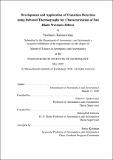| dc.contributor.advisor | Zoltán S. Spakovszky and Edward M. Greitzer. | en_US |
| dc.contributor.author | Ramaswamy, Vaishnavi,S. M.Massachusetts Institute of Technology. | en_US |
| dc.contributor.other | Massachusetts Institute of Technology. Department of Aeronautics and Astronautics. | en_US |
| dc.date.accessioned | 2020-09-03T17:46:13Z | |
| dc.date.available | 2020-09-03T17:46:13Z | |
| dc.date.copyright | 2020 | en_US |
| dc.date.issued | 2020 | en_US |
| dc.identifier.uri | https://hdl.handle.net/1721.1/127085 | |
| dc.description | Thesis: S.M., Massachusetts Institute of Technology, Department of Aeronautics and Astronautics, May, 2020 | en_US |
| dc.description | Cataloged from the official PDF of thesis. | en_US |
| dc.description | Includes bibliographical references (pages 144-148). | en_US |
| dc.description.abstract | This thesis describes a new approach to infrared measurement of boundary layer transition and its implementation in a natural transition experiment on flat and wavy surfaces. The approach relies on computing the convective heat transfer coefficient field on the test surface and inferring transition region from the same. The transition location identified from infrared images is assessed against hotwire measurement which establishes transition location based on the growth of Tollmien-Schlichting waves in the boundary layer. Infrared thermography is used to determine the effects of surface waviness on natural transition in the regime of operation of civil aero engine fan blades. Surface waviness on fan blades arises from the carbon composite manufacturing process. The waviness results in transition point movement due to receptivity amplification between the surface wavelength and Tollmien-Schlichting wavelength, as recently described by Lee [17]. The research, therefore, develops and assesses an improved method for field measurement of transition from infrared images and captures the transition point movement due to surface waviness. The infrared transition detection technique developed here shows good agreement with midspan hotwire measurements (within 5% of chord) for natural transition experiments on a flat plate. Previous infrared based transition inference methods are shown to deviate from hotwire measurements by ~ 30% of chord. The research demonstrates spanwise uniformity in transition location and transition point movement (spanwise variation within 10% of chord) for the experimental configuration, and thereby characterizes the effect of surface waviness on natural transition for a representative fan blade. | en_US |
| dc.description.statementofresponsibility | by Vaishnavi Ramaswamy. | en_US |
| dc.format.extent | 148 pages | en_US |
| dc.language.iso | eng | en_US |
| dc.publisher | Massachusetts Institute of Technology | en_US |
| dc.rights | MIT theses may be protected by copyright. Please reuse MIT thesis content according to the MIT Libraries Permissions Policy, which is available through the URL provided. | en_US |
| dc.rights.uri | http://dspace.mit.edu/handle/1721.1/7582 | en_US |
| dc.subject | Aeronautics and Astronautics. | en_US |
| dc.title | Development and application of transition detection using infrared thermography for characterization of fan blade waviness effects | en_US |
| dc.type | Thesis | en_US |
| dc.description.degree | S.M. | en_US |
| dc.contributor.department | Massachusetts Institute of Technology. Department of Aeronautics and Astronautics | en_US |
| dc.identifier.oclc | 1191824172 | en_US |
| dc.description.collection | S.M. Massachusetts Institute of Technology, Department of Aeronautics and Astronautics | en_US |
| dspace.imported | 2020-09-03T17:46:13Z | en_US |
| mit.thesis.degree | Master | en_US |
| mit.thesis.department | Aero | en_US |
